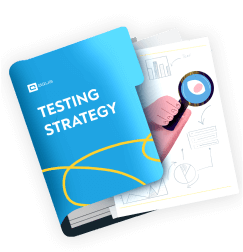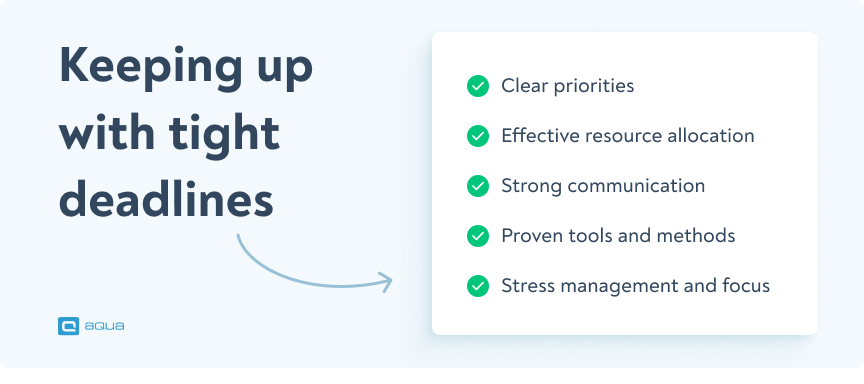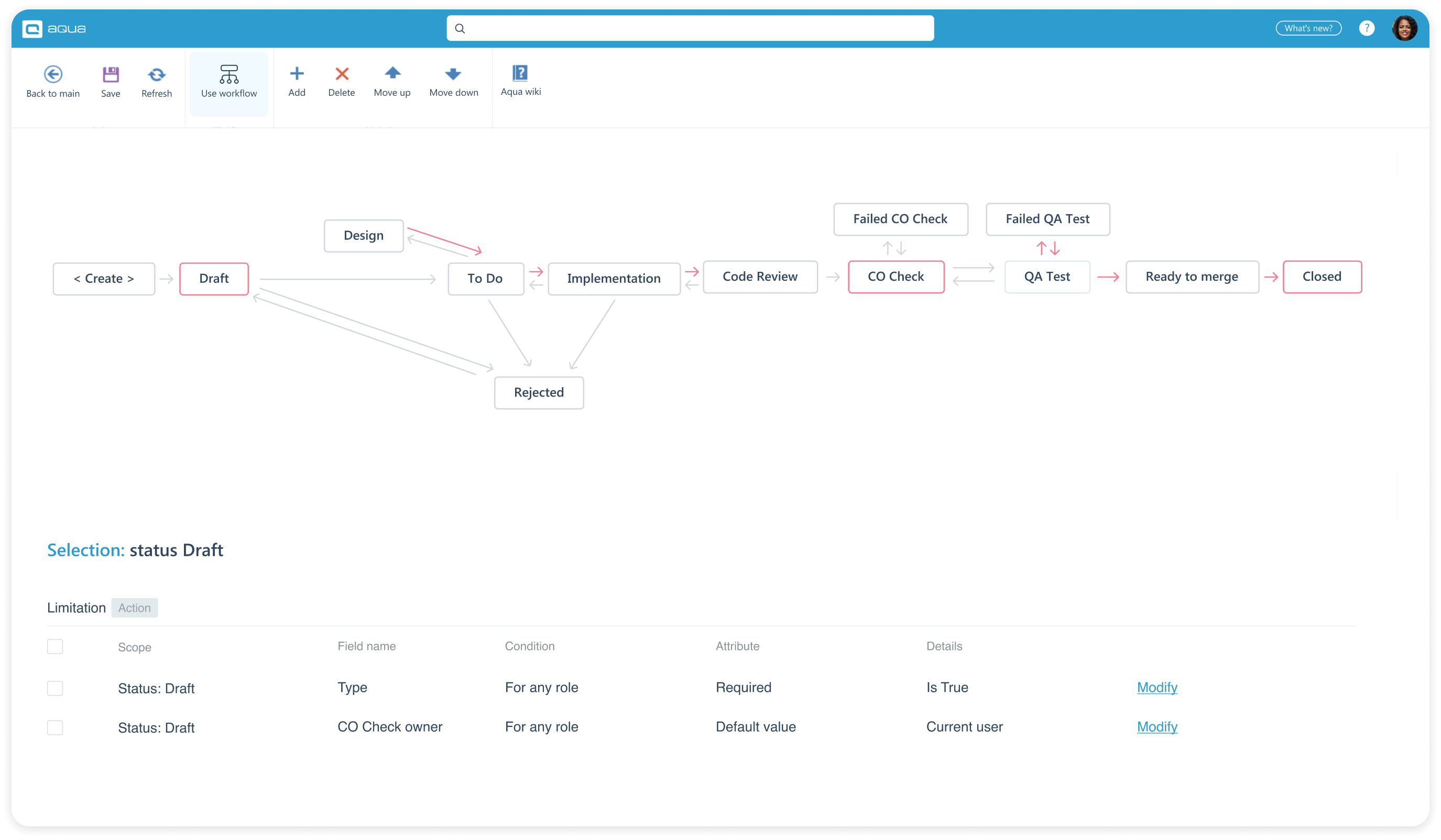Well, no worries! This article will dive deep into the software testing world, unwrapping helpful strategies to help you survive those nail-biting deadlines and improve your software quality. So, buckle up, and let’s start.
What is a deadline in QA?
In QA, as in overall management, a deadline is a predetermined date or time by which you should complete a particular task, project, or deliverable. Deadlines are crucial in QA as they help you ensure testing activities are conducted within specified timeframes to meet project milestones and objectives.
For example, a deadline in QA could be the scheduled completion date for testing a new software release before its deployment to production. QA teams must adhere to this deadline to thoroughly test the software for defects and ensure its quality before it is released to end-users. You should consider your project management system as your deadline-tracking software or deadline-management app. These tools allow teams to set, monitor, and track deadlines for testing tasks and projects. By keeping up with deadlines and proactively managing testing timelines, you can ensure the timely delivery of high-quality software products.
Why does planning in QA matter?
In software development, effective planning in QA is essential for desired outcomes. You should consider planning as the strategic map that guides the journey through unknown territory. It paints a clear picture of objectives, defines the scope, and sets expectations.
Planning is like a compass, ensuring everyone works toward a common goal and preventing potential confusion. Effective time management helps you avoid the chaotic rush that threatens your testing quality. This time-conscious approach keeps your projects on track, preventing deadline slips due to poorly managed schedules. In the big picture, QA planning is more than a step — the framework holds the testing process together.
QA planning is pivotal as the last line of defence before a product’s release. It is a critical checkpoint to ensure the product meets the desired quality standards and functionality. Inadequate planning can lead to rushed testing and overlooking crucial aspects, leading to release timeline delays and frustration for the company and the team members.
Effective QA planning, on the other hand, makes a systematic and thorough testing phase, reducing the likelihood of unforeseen issues cropping up post-release. The well-structured plan ensures that resources are allocated appropriately, necessary tools and environments are in place, and the testing team is aligned with their responsibilities. A strategic QA plan also fosters better communication among cross-functional teams, ensuring everyone understands their role in delivering a high-quality product on schedule.
"I love deadlines. I like the whooshing sound they make as they fly by."
Can we create and manage test milestones and deadlines?
Milestones and deadline management, coupled with practical strategies on how to manage tight deadlines in QA, are necessary for accomplishing successful projects. Milestones are checkpoints that help divide the testing process into manageable stages. You can monitor testing progress with milestones while staying aligned with its primary objectives.
Also, deadlines help you ensure a structured workflow by preventing last-minute scrambles and creating a sense of urgency and accountability among team members. Yet, it’s crucial to balance meeting deadlines and testing quality, as rushed testing can cause issues and lower the quality of your product.
For successful testing, effective communication is essential. Regular team meetings, transparent discussions, and updated team members will help you track the process and promptly address potential issues.
If you aim to elevate your QA test case management, your search ends here. With aqua’s comprehensive testing strategy template, you can discover a guide that explores methodologies, tools, and modern approaches to ensure smooth test management. From Agile and DevOps to creating a software test plan, our template is your ultimate toolkit for test management success. Learn game-changing tactics that streamline test case creation, implementation, and reporting, allowing you to monitor progress and identify areas for improvement quickly.

Transform your test management with aqua's game-changing template
How to keep up with tight deadlines in software testing
Navigating tight deadlines in testing can be challenging. The industry’s ever-changing environment demands efficiency as well as accuracy. So, let’s explore the best strategies to keep up with quality while meeting tight deadlines.
Setting priorities
When time is limited, it’s critical to prioritise testing tasks based on their significance level. Before extensive testing, decide which features are most important and which areas serve the most significant risk. By taking this step, you can be sure that your attention will be focused on the most essential elements, lowering the possibility of missing critical bugs.
Effective resource allocation
To meet challenging deadlines, efficient resource allocation is essential. Understanding the available resources, including testing environments, tools, and team members, will enhance the utilisation of automation tools. Speeding up repetitive tasks with automation tools allows your team to concentrate on more challenging testing parts.
“I manage quality vs deadlines by communicating with my team. If I think we will run out of time to test, I will let them know how much will be tested this round. That way, the product owner knows where we stand and can make any adjustments to the schedule if needed. He can decide if the risk of not testing everything is acceptable or if we need to throw the schedule out the window and test everything.”
Strong communication
Sustaining robust communication between testing and development teams enhances better project execution. Regular check-ins, meetings, and a shared understanding of the project goal can all help to prevent misunderstandings and speed up problem-solving. Also, fostering effective communication among team members encourages collaboration, making overcoming obstacles easier.
Tools and methods
Consider implementing agile development practices like Scrum or Kanban, emphasising continuous improvement and regular testing. These methods are all about keeping flexible and always striving for project development. This way, you’ll continuously receive feedback and make adjustments quickly, preventing changes from delaying your project.
Additionally, tools such as aqua cloud, TestRail, and Jira can significantly enhance your deadline management efforts. aqua’s AI-driven insights empower your team to optimise testing strategies and resource allocation, ensuring real-time progress tracking and timely adjustments. TestRail provides comprehensive test case management and result analysis, while Jira streamlines task creation and progress monitoring.
Stress management and focus
Keeping concentration and managing stress during high-pressure situations can be challenging. But you can always find ways to motivate your team and help them refocus and re-energize. They do not have to be directly tech- or work-related, either.Mindfulness techniques or meditation can also be beneficial in reducing stress and boosting concentration. In addition, by setting up achievable goals and recognising your team members’ achievements, you’ll consistently maintain high team morale and motivation.
To wrap up, successfully managing tight software testing deadlines requires a mix of some innovative strategies. You can improve the willingness of your team to meet deadlines and keep up test quality by prioritising tasks, optimising resource allocation, fostering communication, and carrying out stress-management tactics. Remember, it’s not just about speed; it’s about delivering a reliable end product.

How to define and manage test case approval workflows in aqua?
aqua cloud is an advanced QA management solution crafted to streamline and optimise your testing process comprehensively. From test case inception to execution, its innovative features help you uphold quality standards and adeptly navigate the intricacies of project deadlines. aqua enables QA teams to strategically allocate resources, closely monitor progress, and promptly recalibrate strategies in real-time, all within the context of imminent deadlines by providing an integrated platform for test plan management.
aqua’s cutting-edge features come to the rescue as the QA deadline becomes sooner, making creating and managing test case approval workflows simple. Following the steps, you can oversee these workflows wisely:
- Access workflow configuration: Visit aqua’s platform’s workflow management section. This first step allows you to set up and customise your workflows.
- Initiate workflow creation: Creating a new workflow is crucial; it establishes the framework for processing and approving your test cases. It is critical for clarity to name the workflow and determine its purpose.
- Workflow design: Determining the sequence of status changes is crucial. This influences how test cases move through various phases. For the approval process to stay organised, it must be done to follow the proper order. An important quality assurance step is requiring essential details to be filled out before approval. This step allows incorrect or incomplete data to move forward, improving the workflow’s overall reliability.
- Automate enforcement: Corporating aqua’s automation capabilities is a key step in workflow management, as it sets up rules within the workflow to ensure consistency. You can enforce mandatory stages or reviews, enhancing accuracy and speeding up approvals. Unlike traditional test automation, this focuses on maintaining procedure integrity, ensuring adherence to established protocols, and minimising delays.

Conclusion
This article is an excellent roadmap for successful projects in challenging testing, where tight deadlines loom large. The secrets to maintaining quality while meeting deadlines have been revealed, from strategic planning and milestone management to solid communication and stress management. By implementing these strategies, your team can manage deadlines while ensuring the delivery of reliable, high-quality software products.
And if you are looking for a perfect solution for managing your deadlines and keeping track as a team, look no further than aqua cloud. With AI-driven precision, aqua empowers your team to create, execute, and adapt tests seamlessly, ensuring on-time project delivery without compromising on quality. Say goodbye to the stress of missed deadlines and embrace a future where your QA team effortlessly meets project timelines. Experience the power of this testing software and watch your QA processes transform into a harmonious symphony of efficiency and success.
Conquer your deadlines with a single tool







